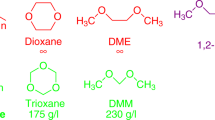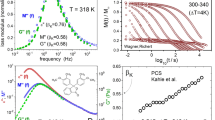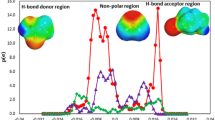Abstract
EXPERIMENTALLY it is indicated that the different total polarisations shown by the same solute when dissolved in different solvents are to be related to alterations in the orientation polarisations (0P) caused by replacement of one dielectric environment by another, the atomic and electronic polarisations being constant throughout such changes. Therefore the expression given by Raman and Krishnan1 for the volume polarisation of a dielectric, namely: (cf. reference for definition of symbols) can be rewritten to show the molecular orientation polarisation (0Psol.) of a polar solute at infinite dilution in a non-polar medium of dielectric constant ϵ as: Now, dividing throughout by the true orientation polarisation as observed in the gaseous state (oPgas = 4N2/9kT) we have
This is a preview of subscription content, access via your institution
Access options
Subscribe to this journal
Receive 51 print issues and online access
$199.00 per year
only $3.90 per issue
Buy this article
- Purchase on Springer Link
- Instant access to full article PDF
Prices may be subject to local taxes which are calculated during checkout
Similar content being viewed by others
References
Raman and Krishnan, Proc. Roy. Soc., A, 117, 589; 1927.
Trans. Far. Soc., 1934, Appendix.
Briegleb und Wolf, Fortsch. Chem., 21, Pt. 3; 1931.
Le Fèvre, Chem. and Ind., April 5, 1935, p. 316; and J. Chem. Soc., June, 1935, p. 773.
Author information
Authors and Affiliations
Rights and permissions
About this article
Cite this article
LE FÈVRE, R. Molecular Polarisation of Solutes and Dielectric Constant of Solvents. Nature 136, 181–182 (1935). https://doi.org/10.1038/136181b0
Issue Date:
DOI: https://doi.org/10.1038/136181b0
This article is cited by
Comments
By submitting a comment you agree to abide by our Terms and Community Guidelines. If you find something abusive or that does not comply with our terms or guidelines please flag it as inappropriate.



